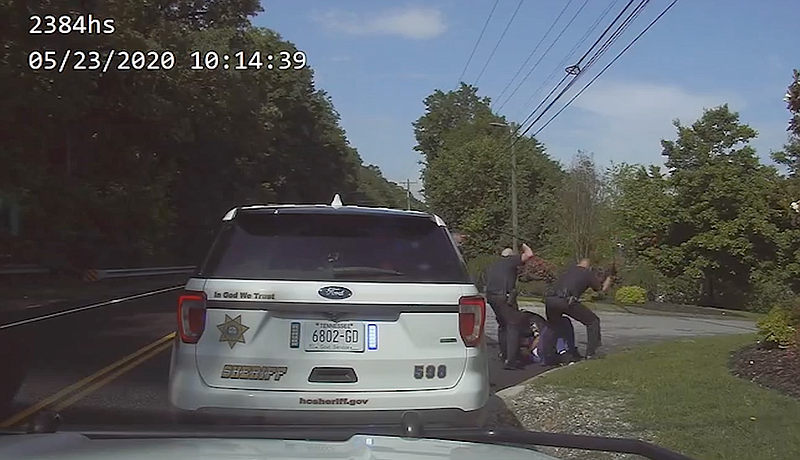The union representing five Hamilton County sheriff's deputies involved in the May 23 arrest of a Black man in Ooltewah stepped forward Thursday to say the officers did not beat the man.
Union leaders called the district attorney's decision to release dashboard camera footage an attempt to "pollute the jury."
The video shows the deputies - Sgt. Mickey Rountree, Cpl. Brian Killingsworth and deputies Nick Dewey, Todd Cook and Lori Choate - striking 32-year-old Reginald Arrington Jr. with batons.
For five-and-a-quarter minutes, the deputies - all white - struck Arrington and held him to the ground, the video shows. They had been called to the area by a neighbor who told deputies that a Black man in a blue jumpsuit was acting suspiciously, walking up to women and "asking them questions and asked her how to get out of the neighborhood," court records state.
Officers reported they saw the man walking south on Old Lee Highway "in violation of the pedestrian on roadway law," which is what precipitated the arrest.
All charges against Arrington since have been dropped, and upon dismissing the case, District Attorney General Neal Pinkston released the dashboard camera footage and asked the Tennessee Bureau of Investigation to review the arrest.
The move was met with pushback from Hamilton County Sheriff Jim Hammond, who called Pinkston's decision to release the footage an attempt to "indict my deputies in the court of public opinion prior to facts being presented in a court of law."
Arrington's attorney, Troy Bowlin II, supported release of the videos in a statement.
"Transparency is part of the mesh which serves to stimulate community trust in our government," Bowlin said in an email. "To not release videos and records deteriorates this trust. The release of videos and documents do not change the integrity of the evidence and therefore should be subject to public disclosure."
Vince Champion, southeast regional director for the International Brotherhood of Police Officers, said Thursday during a news conference, "We need to let the system work. And then once that's over, whatever happens at that point, be it discipline or not, then we will handle that situation from there."
Champion said the video should have not been released, especially not "without any kind of context," because it's evidence in the investigation into the five deputies.
"To put it out without any kind of context or explain exactly what it's there for or for the reasoning, it appears to be nothing more than, for the, you know, for the DA to get, you know, to, quite honestly pollute the jury duty at this point, because he's putting it out there trying to have everybody else make up their own mind before they know what the real facts are, whatever those facts may be," he said.
In a news release on Tuesday, the DA's office stated that its reason for providing the videos to the public was "In an effort to be as transparent as possible[.]"
Champion said he's never against transparency in law enforcement, but his problem with the videos being released too quickly is that "95% of every video you've probably ever seen" of an arrest or police shooting, "it doesn't look good. I mean, our job just doesn't look good on video."
If the videos were released with proper context, he said, he would be supportive of that.
"But once you just put it out there and let the public make up their own mind, we've seen how that's going," he said. "Everybody's gonna go to their respective sides It's a tool to divide more so than to be transparent, unless you put the full context with it."
He said an explanation of what the officers were doing and why they did it would have helped.
For example, he said, the deputies did not beat Arrington. They were "trying to get the compliance that was needed, and to use the force needed to effect the arrest that was used against the officers.
"The strikes were very light in comparison to gain - we call 'em pain compliance," he said. "Just enough to hit - to get somebody to comply with what you're doing."
When asked his definition of a beating, Champion said, "That's up to you. Everybody has a different definition, and as I said, I'm not here to discuss what a beating is or what a beating isn't. What I'm here to discuss is that officers used the necessary force to effect the arrest."
As proof that the strikes were calculated, Champion went on to claim the deputies did not rear their arms all the way back before hitting Arrington.
Dashboard camera video shows deputies repeatedly rearing their arms, batons in hand, all the way back before hitting Arrington.
"He's lifting the arm up, but he never brings it down," Champion said. "Get the full video."
Ultimately, Champion said, the videos should not have been released until the investigation was completed.
"The end game, of course, is to show that the officers do their training, their abilities as a law enforcement officer to effect an arrest," he said. "And again, you know, whether you agree or you don't, there's clearly statute that they had to do that [make the arrest]. Whether the officer could have let him go or not - you know, the officer lets him go and he gets hit on that road. Are we now going to have the conversation that the officer didn't do his job because he let him walk on the wrong side of the road and get run over?"
Contact Rosana Hughes at rhughes@timesfreepress.com or 423-757-6327 with tips or story ideas. Follow her on Twitter @Hughes Rosana.
